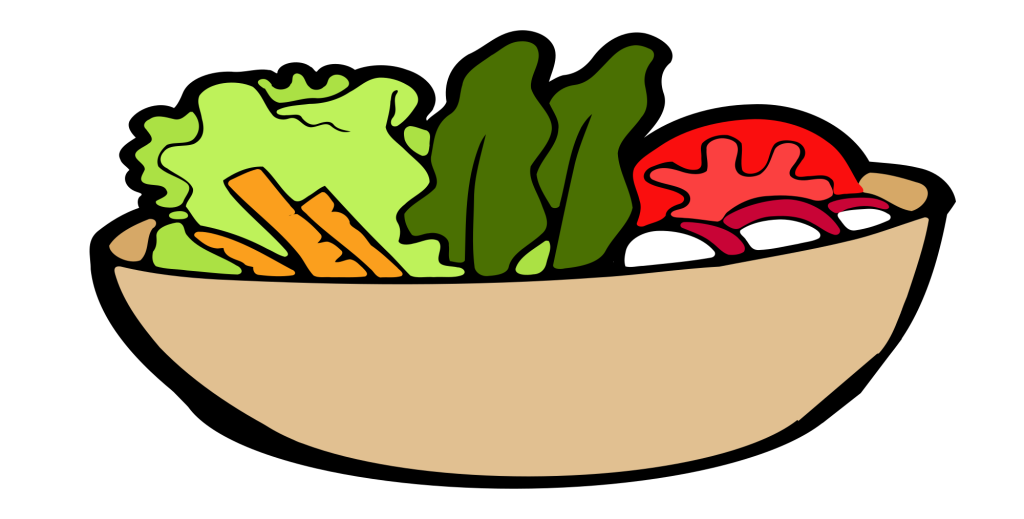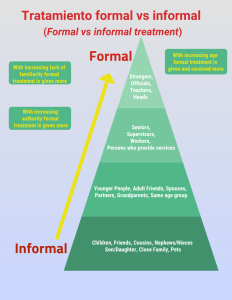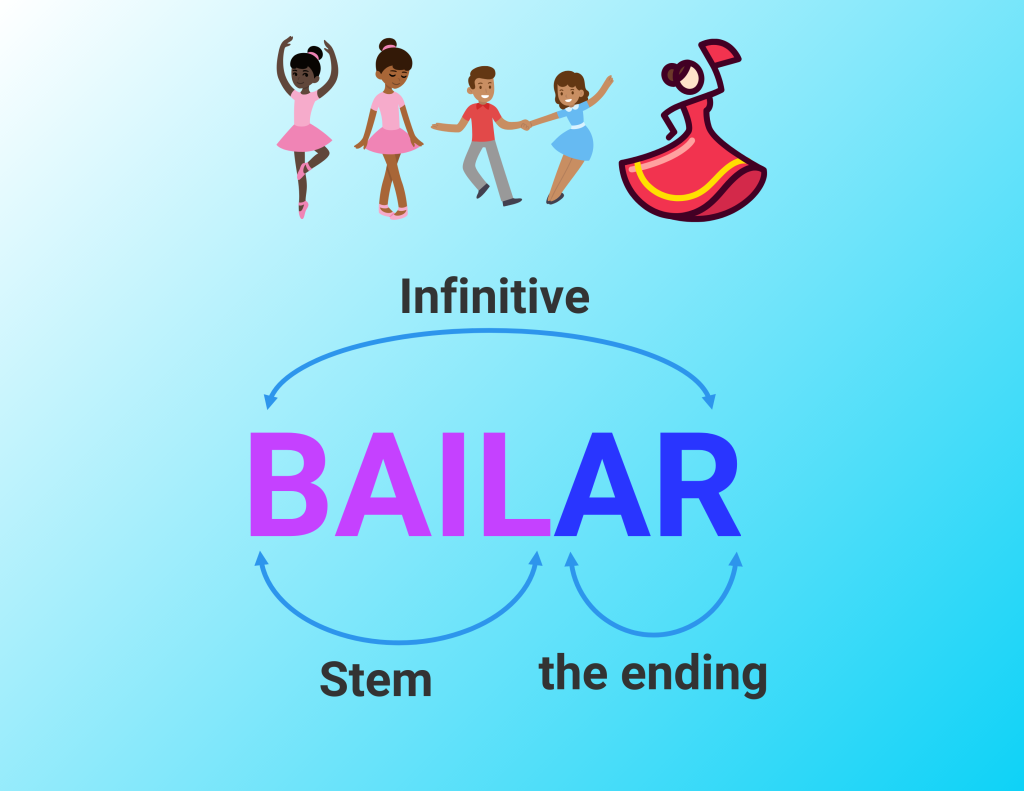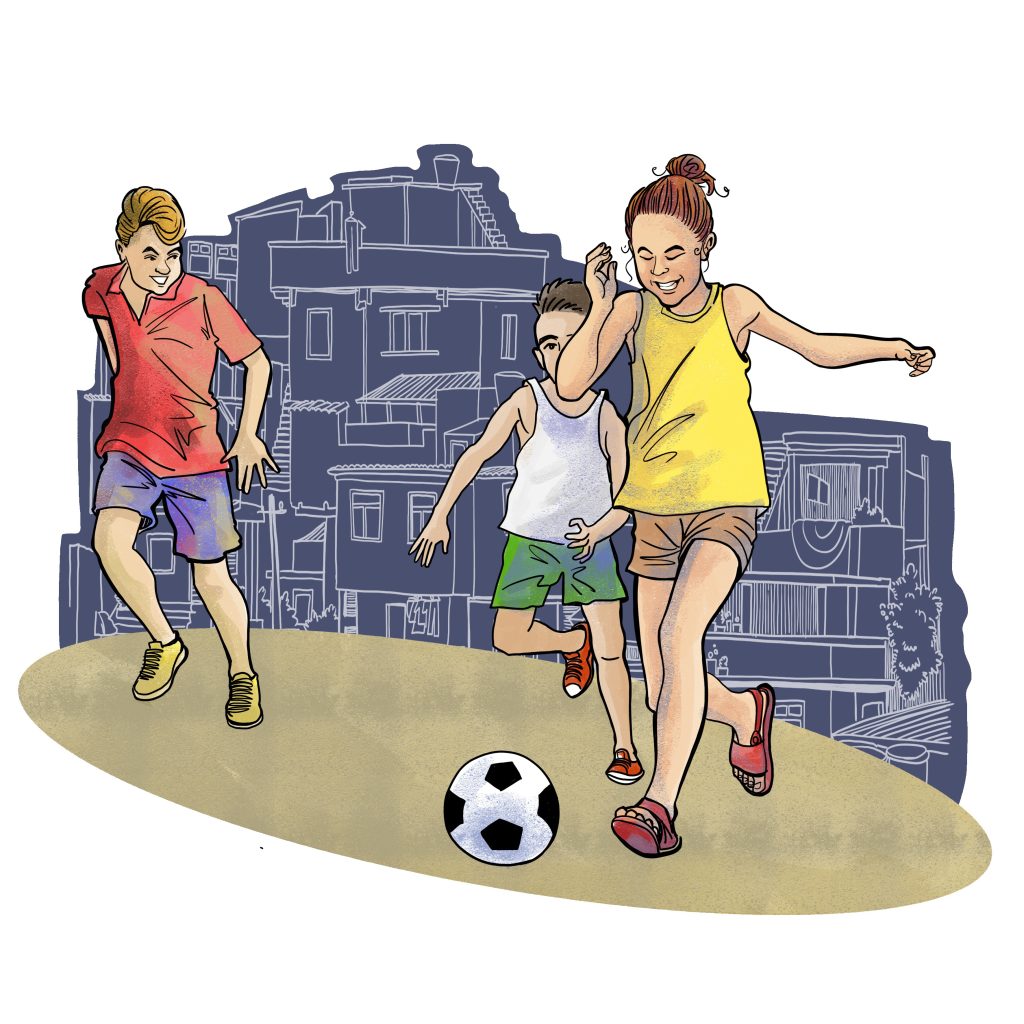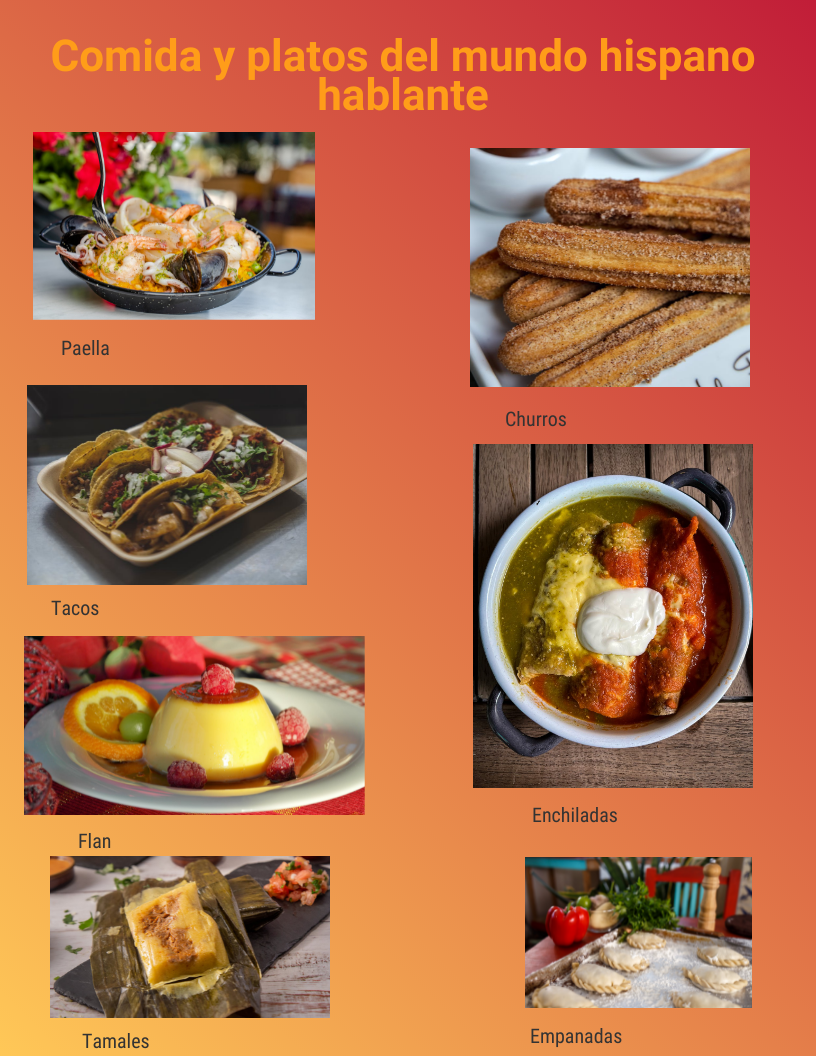Unidad 5 – Primera Parte (Part 1)
Vocabulario
(Vocabulary)
El menú en español (The menu in Spanish)
En español, los menús en los restaurantes se dividen en cuatro partes:
1) Los refrescos:
| Las bebidas | Drinks | ||
|---|---|---|---|
| Café / té | Coffee/ tea | ||
| Agua mineral | Mineral water | ||
| Jugo de fruta | Fruit juice | ||
| Limonada | Lemonade | ||
| Soda | Soda | ||
| Vino (blanco/tinto) | Wine (white/red) | ||
| Cerveza | Beer | ||
| Cóctel | Cocktail |
| Carnes | Meats |
|---|---|
| Lomo de res | Prime rib |
| Bistec | Steak |
| Chuleta de puerco | Pork chop |
| Guisado de (carne/pollo) | Beef/chicken stew |
| Pollo (frito/asado) | Chicken (fried/roasted) |
| Los Mariscos | Seafood | |
|---|---|---|
| Camarones | Shrimp | |
| Almejas | Clams | |
| Langosta | Lobster | |
| Pescado (frito/asado) | Fish (fried/roasted) |
| Las Sopas | Soups |
|---|---|
| Caldo de pollo | Chicken soup |
| Sopa de carne | Beef soup |
| Sopa de mariscos | Seafood soup |
| Sopa de fideos | Noodle soup |
| Gazpacho | Gazpacho (cold tomato based soup) |
| Platos adicionales | Side dishes |
|---|---|
| Ensalada verde con lechuga y tomate | Green salad with lettuce and tomato |
| Ensalada de papas | Potato salad |
| Papas fritas | French fries |
| Arroz | Rice |
| Frijoles fritos | Fried beans |
| Tortillas | Tortillas |
| Puré de papas | Mashed potatoes |
4. Los postres:
| Los Postres | Dessert | |
|---|---|---|
| Flan | Custard | |
| Galletas | Cookies | |
| Pastel | Cake | |
| Helado (de vainilla/ de chocolate) | Ice cream (vanilla/chocolate) |
Cómo usarlo
(How to use it)
En la unidad 1 you learned that el español differentiates between formal and informal treatment through the use of the pronouns usted y tú respectively.
Tú también learned that despite some differences in the way Spanish speakers engage with formal vs. informal treatment, a general rule is that within the Spanish-speaking world, these treatments are part of the culture and more or less are determined by the following people to whom we may address:
Entonces, en español, when ordering in a restaurant we tend to prefer polite language and the use of usted when engaging with the server en un restaurante. This treatment will include using words like the following:
- podría (usted) = could you
- puede (usted) = can you
- (Yo) quisiera = I would like
Haz clic en la lista de vocabulario below to learn some common expressions used in a restaurant:
¡A practicar!:
Pretend you are at a Spanish-speaking restaurant and make an order including the following things: (make sure to use polite words like the ones above when ordering)
- Order a drink
- Order a main dish
- Order a side dish
- Order a dessert
Copy and paste the following letters and symbols as needed.
á é í ó ú ñ Á É Í Ó Ú Ñ ¡ ! ¿ ?
Gramática
(Grammar)
1. Verbos con cambio de vocal[1] en el presente simple indicativo
(Vowel-change verbs in simple present tense)
En la unidad 3 you learned how to conjugate verbos regulares -ar, -er , -ir en el presente simple indicativo.
Tú también learned that in order to conjugate un verbo infinitivo en el presente simple indicativo (simple present tense) the stem will not change, but the ending must be taken out and apply the patterns of conjugation for verbs ending in –ar, -er, -ir previously studied.
En español some regular verbs ending in -ar, -er, -ir, carry a vowel change in the stem when conjugated en el presente simple indicativo.
These verbos con cambio de vocal (vowel-change verbs) se dividen en 3 categorías:
- Verbos that change the vowel from e to i
- Verbos that change the vowel from e to ie
- Verbos that change the vowel from o to ue
When conjugating los verbos con cambio de vocal en el presente simple indicativo, you do both, change the ending of either -ar, -er, -ir verbs and make the vowel change in the stem of the verb for all subject pronouns except in the following subject pronouns:
- Nosotros / Nosotras
- Vos (instead of or alternate with Tú in Latin America)
- Vosotros / Vosotras (instead of Ustedes in Spain and Equatorial Guinea)
Mira la imagen que sigue to be reminded that the vowel change in the stem of the verb occurs in the subject pronouns inside the boot and does not occur with the pronouns outside the boot:
1. E to I: Verbos con cambio de vocal from e to i
(Verbs with vowel-change from e to i)
Los verbos que siguen have a vowel change from e to i en el presente simple indicativo:
| Vowel Changing verbs (e) to (i) | ||||
|---|---|---|---|---|
| Pedir | To ask for something | |||
| Servir | To serve | |||
| Repetir | To repeat | |||
| Conseguir | To get, to obtain | |||
| Seguir | To follow | |||
| Sonreír | To smile | |||
| Vestir | To wear |
Below you will find an example of the vowel-changing verb “servir” that changes e to i.
| Servir | ||||
|---|---|---|---|---|
| Yo | sirvo | |||
| Tú | sirves | |||
| Usted, Él, Ella | sirve | |||
| Nosotros, Nosotras | servimos (no stem vowel change) | |||
| Ustedes, Ellos, Ellas | sirven |
2. E to IE: Verbos con cambio de vocal from e to ie
(Verbs with vowel-change from e to ie)
Los verbos que siguen have a vowel change from e to ie en el presente simple indicativo:
| Vowel changing verbs (e) to (ie) | ||
|---|---|---|
| Comenzar (a) | To start (to) | |
| Empezar (a) | To beging (to) | |
| Entender | To understand | |
| Pensar en | To think of/in/about | |
| Perder | To lose | |
| Preferir | To prefer | |
| Querer | To want, to love | |
| Sentir | To feel | |
| Cerrar | To close | |
| Tener (except "yo") | To have | |
| Venir (except "yo") | To come | |
| Mentir | To lie | |
| Sugerir | To suggest |
Below you will find an example of the vowel-changing verb “sentir” that changes e to ie.
| Sentir | ||||
|---|---|---|---|---|
| Yo | siento | |||
| Tú | sientes | |||
| Usted, Él, Ella | siente | |||
| Nosotros, Nosotras | sentimos (no stem vowel-change) | |||
| Ustedes, Ellos, Ellas | sienten |
3. O to UE: Verbos con cambio de vocal from o to ue
(Verbs with vowel-change from o to ue)
Los verbos que siguen have a vowel change from o to ue en el presente simple indicativo:
| Vowel changing verbs (o) to (ue) | ||
|---|---|---|
| Dormir | To sleep | |
| Almorzar | To eat lunch | |
| Encontrar | To find | |
| Poder | To be able to | |
| Sonar | To ring | |
| Soñar (con) | To dream (of) | |
| Volver | To return | |
| Contar | To count, to tell, to narrate | |
| Morir | To die | |
| Jugar | to play (activities, sports) |
Below you will find an example of the vowel-changing verb “dormir” that changes o to ue.
| Dormir | ||||
|---|---|---|---|---|
| Yo | duermo | |||
| Tú | duermes | |||
| Usted, Él, Ella | duerme | |||
| Nosotros, Nosotras | dormimos (no stem vowel-change) | |||
| Ustedes, Ellos, Ellas | duermen |
¡IMPORTANTE!
Jugar = means to play a sport, play a game or play with a toy. Jugar is the only vowel-changing verb from u to (ue) and is normally grouped with verbs that change vowel from o to (ue).
2. Los verbos “Poder”, “Preferir” y “Querer”
(Verbs “To be able to”, “To prefer” and “To want”)
Just with like la expresión “tener que” and verbs that express gustos y disgustos (gustar, encantar, interesar, molestar, etc.) los verbos “poder”, “preferir” y “querer” are followed by un verbo en infinitvo.
- Yo no puedo hablar chino. Yo puedo hablar portugués.
- Yo prefiero ir al cine los sábados en la noche.
- Mi amiga Catalina prefiere comer pollo en vez de carne.
- El próximo verano yo quiero viajar a Colombia.
Preferir y querer can also be followed by objetos.
- Yo prefiero café porque no me gusta el té.
- Nosotras queremos galletas.
- ¿Quieren una cerveza?
¡ATENCIÓN!
As studied above, el verbo poder es un verbo con cambio de raíz (stem vowel-change) from o to ue en el presente simple indicativo. Preferir y querer son verbos con cambio de raíz (stem vowel-change) from e to ie en el presente simple indicativo so when using them you also must apply this stem vowel-change learned above.
¡A practicar!
Note: In Spanish, we have a verb for eating each meal of the day:
Mira el vocabulario del menú learned en la sección de vocabulario above y responde a las preguntas que siguen in full sentence:
Copy and paste the following letters and symbols as needed.
á é í ó ú ñ Á É Í Ó Ú Ñ ¡ ! ¿ ?
Cultura hispanohablante
(Spanish-speaking Culture)
Las comidas y platos locales en el mundo hispanohablante
(Local food and dishes in the Spanish-speaking world)
You already learned that las familias en el mundo hispanohablante tend to share similar values on how they build and maintain relationships with others.
- Las personas hispanohablantes maintain high-contact with los miembros de la familia nuclear y otros parientes.
- Las personas hispanohablantes maintain high-contact with los amigos y las amigas.
Entonces, la comida es muy important en la cultura hispanohablante as it becomes a means to connect with others, and to form and maintain relationships.
Each Spanish-speaking country has different platos de comida local:
¿Sabías que…? (Did you know…?)
La sopa de gazpacho (Gazpacho soup) es una sopa fría muy popular en España.
Mira el video que sigue to learn Cómo hacer Gazpacho (how to make Gazpacho) y haz una lista de los ingredientes de la sopa de gaspacho.
En mi opinión…
¿Qué plato local learned above would you like to try or order en un restaurante?
Does your culture or country where you live have local dishes? Are any of these dishes similar to los platos locales de países hispanohablantes learned above? Share in English.
Media Attributions
- Table and menu © Terje Sollie is licensed under a CC0 (Creative Commons Zero) license
- Drinks set © OpenClipart is licensed under a Public Domain license
- Cooked Chicken © OpenClipart is licensed under a Public Domain license
- Bowl of salad © OpenClipart is licensed under a Public Domain license
- Variety of desserts © OpenClipart is licensed under a Public Domain license
- Tratamiento formal vs informal © Constanza Rojas-Primus is licensed under a CC BY-NC (Attribution NonCommercial) license
- Partes del verbo infinitivo © Ana Robles and Constanza Rojas-Primus is licensed under a CC BY-NC (Attribution NonCommercial) license
- Pronombres sujeto con y sin cambio de vocal en la raíz © Constanza Rojas-Primus and Ana Robles is licensed under a CC BY-NC (Attribution NonCommercial) license
- Children playing soccer © lengerke is licensed under a CC BY-NC (Attribution NonCommercial) license
- Comida y platos del mundo hispano hablante © Ana Robles is licensed under a CC BY-NC (Attribution NonCommercial) license
- Also known as "verbos con cambios de raíz" (stem-changing verbs) ↵
menu
are divided
click on
drinks
main dishes
side dishes
desserts
let´s practice!
also
then, hence
you - informal
infinitive, any verb or action that is preceded by the word 'to' in English is an infinitive. For example: to love, to eat, to run, to be, to believe, to follow, to laugh, etc. This means that the actions are not yet conjugated in the present tense or in any other tense.
look at, watch
what follows, below
that follow
important!
to play
must, to be obligated to
likes
dislikes
for example
instead of
objects
cookies
attention!
to be able to
prefer
to want, to desire
to eat breakfast
to have lunch
to eat dinner
more practice!
choose
and
local food
cold soup
make a list
ingredients
in my opinion




